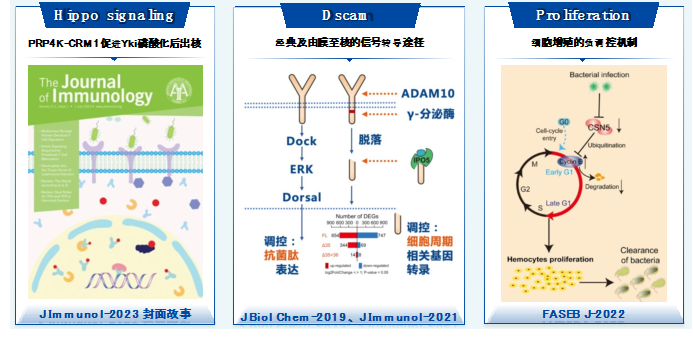发布于:2024-01-10

李伟微,男,汉族,1985年10月生,教授,博士生导师。国家“优秀青年科学基金”获得者。2011年于华东师范大学获得理学博士学位,2011 – 2013年于日本大阪大学免疫学前沿研究中心(Immunology Frontier Research Center,IFReC)从事博士后研究,2013年7月 – 2023年2月于华东师范大学生命科学学院先后任副研究员(硕导)及紫江青年研究员(博导)。曾任华东师范大学生命科学学院院长助理及分子动物学平台主任、中国动物学会甲壳动物学分会副秘书长、上海市动物学会理事等职。以通讯作者在J Biol Chem、J Immunol、FASEB J等国际知名期刊发表40余篇学术论文,相关成果受到国际知名专家的重点引用和正面评价,并被编入国际权威专著。主持国家自然科学基金、上海市青年科技启明星和上海市自然科学基金等国家和省部级项目。培养多名研究生获得国家奖学金、上海市优秀毕业生并赴海外知名大学或研究机构攻读博士学位或从事博士后研究,培养多名本科生以第一作者在领域内权威SCI期刊发表学术论文。
一、 研究方向
1.唐氏综合征细胞粘附分子(Dscam)的类抗体作用机制。解析Dscam基因产生万种可变剪接的分子机制,揭示Dscam特异性识别病原的作用机理,厘清Dscam的细胞免疫信号转导及病原信号调控Dscam可变剪接的分子机制,从细胞亚群及单细胞的维度探究Dscam的可变剪接及分子免疫学机制。
2.循环血细胞增殖分化的分子机理。明确河蟹血细胞亚群的基础构成,鉴定具
有增殖分化能力的细胞亚群并开发其特异性分子标记,阐明河蟹循环血细胞增殖分化的内在驱动力及外在诱因,探究循环血细胞增殖介导的免疫学功能。
3.甲壳动物主要病原的致病机理。通过对甲壳动物主要病原致病抗原属性和毒
力机制分析,解析病原的致病机理及其与宿主的相互作用,进行绿色抗病药物筛选和疫苗研发。
二、 主持项目
[1]. 国家自然科学基金优青项目,32322083,2024.01 – 2026.12
[2]. 上海市青年科技启明星,20QA1403000,2020.06 – 2023.05
[3]. 国家自然科学基金面上项目,31972820,2020.01 – 2023.12
[4]. 国家自然科学基金青年项目,31602189,2017.01 – 2019.12
[5]. 上海市自然科学基金,15ZR1410800,2015.01 – 2017.12

三、 代表性论文(updated in Sept 2023)
[1].Qin, YK., Zhao, K., Zhou, KM., Luo, Z., Nan, XY., Wang, Q., and Li, WW. (2023) Subcellular translocation of yorkie through the PRP4K-CRM1 axis regulates antimicrobial peptides transcription and defense against bacterial infection in crab. Journal of Immunology, 211: 43-56. (Cover Story)
[2].Zhou, KM., Qin, YK., Song, Y., Zhao, K., Pan, WJ., Nan, XY., Wang, Y., Wang, Q., and Li, WW. (2022) A novel Ig domain–containing C-type lectin triggers the intestine–hemocyte axis to regulate antibacterial immunity in crab. Journal of Immunology, 208: 2343-2362.
[3].Zhao, H., Chen, Z., Li, H., Zhao, YH., Wang, Q., and Li, WW. (2022) Suppressed COP9 signalosome 5 promotes hemocyte proliferation through Cyclin E in the early G1 phase to defend against bacterial infection in crab. FASEB Journal, 36: e22321.
[4].Zhao, YH., Li, H., Zhao, H., Sun, WK., Wang, Q., and Li, WW. (2021) An ancient interleukin-16-like molecule regulates hemocyte proliferation via integrin β1 in invertebrates. Journal of Biological Chemistry, 297: 100943.
[5].Sun, WK., Li, H., Zhao, YH., Bai, LW., Qin, YK., Wang, Q., and Li, WW. (2021) Distinct vitellogenin domains differentially regulate immunological outcomes in invertebrates. Journal of Biological Chemistry, 296: 100060.
[6].Li, H., Jin, XK., Zhou, KM., Zhao, H., Zhao, YH., Wang, Q., and Li, WW. (2021) Down syndrome cell adhesion molecule triggers membrane-to-nucleus signaling-regulated hemocyte proliferation against bacterial infection in invertebrates. Journal of Immunology, 207: 2265-2277.
[7].Yang, L., Li, XJ., Qin, X., Wang, Q., Zhou, KM., Li, H., Zhang, X., Wang, Q., and Li, WW. (2019) Deleted in azoospermia-associated protein 2 regulates innate immunity by stimulating Hippo signaling in crab. Journal of Biological Chemistry, 294: 14704-14716.
[8].Li, D., Wan, ZC., Li, XJ., Duan, M., Yang, L., Ruan, ZC., Wang, Q., and Li, WW. (2019) Alternatively spliced down syndrome cell adhesion molecule (Dscam) controls innate immunity in crab. Journal of Biological Chemistry, 294: 16440-16450.
[9]. Li, XJ., Yang, L., Li, D., Zhu, Y., Wang, Q., and Li, WW. (2018) Pathogen-specific binding soluble down syndrome cell adhesion molecule (Dscam) regulates phagocytosis via membrane-bound Dscam in crab. Frontiers in Immunology, 9: 801.
四、 联系方式
地址:上海市浦东新区沪城环路999号上海海洋大学水产与生命学院
邮编:201306
邮箱:wwli@shou.edu.cn
